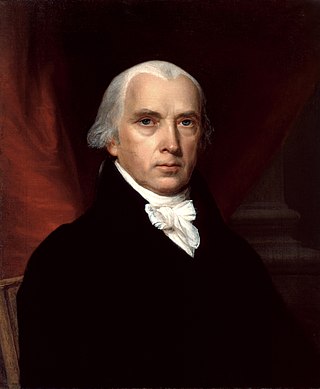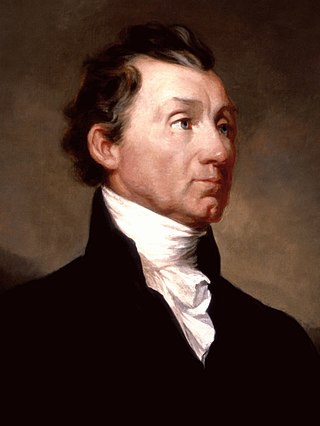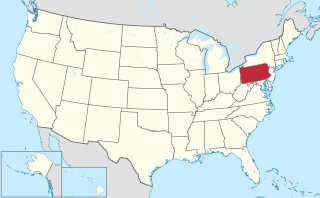
The 1792 United States presidential election was the second quadrennial presidential election. It was held from Friday, November 2, to Wednesday, December 5, 1792. Incumbent President George Washington was elected to a second term by a unanimous vote in the electoral college, while John Adams was re-elected as vice president. Washington was essentially unopposed, but Adams faced a competitive re-election against Governor George Clinton of New York.

The 1796 United States presidential election was the third quadrennial presidential election of the United States. It was held from Friday, November 4 to Wednesday, December 7, 1796. It was the first contested American presidential election, the first presidential election in which political parties played a dominant role, and the only presidential election in which a president and vice president were elected from opposing tickets. Incumbent vice president John Adams of the Federalist Party defeated former secretary of state Thomas Jefferson of the Democratic-Republican Party.

The 1812 United States presidential election was the seventh quadrennial presidential election. It was held from Friday, October 30, 1812, to Wednesday, December 2, 1812. Taking place in the shadow of the War of 1812, incumbent Democratic-Republican President James Madison defeated DeWitt Clinton, the Lieutenant Governor of New York and Mayor of New York City, who drew support from dissident Democratic-Republicans in the North as well as Federalists. It was the first presidential election to be held during a major war involving the United States.

The 1816 United States presidential election was the eighth quadrennial presidential election. It was held from November 1 to December 4, 1816. In the first election following the end of the War of 1812, Democratic-Republican candidate James Monroe defeated Federalist Rufus King. The election was the last in which the Federalist Party fielded a presidential candidate.

The 1820 United States presidential election was the ninth quadrennial presidential election. It was held from Wednesday, November 1, to Wednesday, December 6, 1820. Taking place at the height of the Era of Good Feelings, the election saw incumbent Democratic-Republican President James Monroe win re-election without a major opponent. It was the third and the most recent United States presidential election in which a presidential candidate ran effectively unopposed. As of 2024, this is the most recent presidential election where an incumbent president was re-elected who was neither a Democrat nor a Republican, before the Democratic-Republican party split into separate parties. This election and the 2012 election are the only ones in U.S. history, to date, in which a third consecutive president was elected to a second consecutive term.

The 2004 United States presidential election in Pennsylvania took place on November 2, 2004, and was part of the 2004 United States presidential election. Voters chose 21 representatives, or electors to the Electoral College, who voted for president and vice president.

In the United States Electoral College, a faithless elector is an elector who does not vote for the candidates for U.S. President and U.S. Vice President for whom the elector had pledged to vote, and instead votes for another person for one or both offices or abstains from voting. As part of United States presidential elections, each state selects the method by which its electors are to be selected, which in modern times has been based on a popular vote in most states, and generally requires its electors to have pledged to vote for the candidates of their party if appointed. A pledged elector is only considered a faithless elector by breaking their pledge; unpledged electors have no pledge to break. The consequences of an elector voting in a way inconsistent with their pledge vary from state to state.

The 1860 United States presidential election in Pennsylvania took place on November 6, 1860, as part of the 1860 United States presidential election. Voters chose 27 representatives, or electors to the Electoral College, who voted for president and vice president.

The 1832 United States presidential election in Pennsylvania took place between November 2 and December 5, 1832, as part of the 1832 United States presidential election. Voters chose 30 representatives, or electors to the electoral college, who voted for president and vice president.

The 1800 United States presidential election in Pennsylvania took place on December 1, 1800 during a special session of the Pennsylvania General Assembly. Members of the bicameral state legislature chose 15 electors to represent Pennsylvania in the Electoral College as part of the 1800 United States presidential election. Eight Democratic-Republican electors and seven Federalist electors were selected. Unlike in the previous election, when one elector split his ballot between Republican Thomas Jefferson and Federalist Thomas Pinckney, all 15 electors followed the party line, with the Republicans voting for Jefferson and the Federalists for incumbent President John Adams. This was the first and only U.S. presidential election in which Pennsylvania's electors were not chosen by popular vote.

The 1796 United States presidential election in Pennsylvania took place as part of the 1796 United States presidential election. Voters chose 15 representatives, or electors to the Electoral College, who voted for President and Vice President.

The 1792 United States presidential election in Pennsylvania took place as part of the 1792 United States presidential election. Pennsylvania voters chose 15 members of the Electoral College, each of whom, under the provisions of the Constitution prior to the passage of the Twelfth Amendment, cast two votes for President.

United States presidential elections in Pennsylvania occur when voters in the U.S. Commonwealth of Pennsylvania cast ballots for electors to the Electoral College as part of a national election to elect the President and Vice President of the United States. Regularly scheduled general elections occur on Election Day, coinciding with elections in the other 49 states and the District of Columbia.

The 1956 United States presidential election in Maryland took place on November 6, 1956, as part of the 1956 United States presidential election. State voters chose nine representatives, or electors, to the Electoral College, who voted for president and vice president.

The 1816 United States presidential election in Connecticut took place between November 1 to December 4, 1816, as part of the 1816 United States presidential election. The state legislature chose nine representatives, or electors to the Electoral College, who voted for President and Vice President.

The 1816 United States presidential election in Tennessee took place between November 1 and December 4, 1816, as part of the 1816 United States presidential election. Voters chose eight representatives, or electors, to the Electoral College, who voted for President and Vice President.

The 1812 United States presidential election in Maryland took place on an unknown date in 1812, as part of the 1812 presidential election. Voters chose eleven representatives, or electors to the Electoral College, who voted for President and Vice President.

The 1816 United States presidential election in Maryland took place on an unknown date in 1816, as part of the 1816 presidential election. Voters chose eleven representatives, or electors to the Electoral College, who voted for President and Vice President.


















